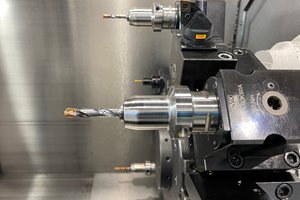Stepping Up To Hole-Making Challenges
Lately, several cutting tool manufacturers have re-examined indexable insert drills, seeking to overcome the disadvantages of unbalanced cutting forces inherent in their design. One of the most recent developments along these lines is the CoroDrill 880 introduced by Sandvik Coromant.
Share





This video demonstrates the use of stepped insert designs in hold making operations
The problem with many indexable insert drills is that they have two inserts whose cutting edges overlap to produce the correct cutting diameter. So even though the drill has two flutes, the inserts function as a single but asymmetrical cutting edge. Such designs are inherently unbalanced. As a result, indexable drills have had to compromise feed and speed when entering a cut, forcing the user to make a trade-off between economy and productivity.
Another problem with the unbalanced entry is hole tolerance. Typically, the center insert of an indexable drill enters first. This creates a large radial cutting force, which tends to cause deflection in the drill body. Once the drill is pushed off-center, it cannot produce a close-tolerance hole.
For these reasons, indexable drills have generally been limited to rough drilling of holes. Where tolerances closer than 0.012 to 0.016 inch total are required, it has been necessary to follow the indexable drill with a secondary operation.
Lately, several cutting tool manufacturers have re-examined indexable insert drills, seeking to overcome the disadvantages of unbalanced cutting forces inherent in their design. One of the most recent developments along these lines is the CoroDrill 880 introduced by Sandvik Coromant (Fair Lawn, New Jersey). According to Bruce Carter, a Sandvik product specialist, the design of this indexable drill sidesteps the problems created by unbalanced cutting forces, thus improving productivity and hole quality while retaining the economy of having inserts with four usable edges.
The key is a concept that the company calls "Step Technology." This phrase describes the "step-by-step" entrance of the insert cutting edges into the workpiece, which is said to greatly reduce the radial cutting forces associated with indexable drills in the past. The concept involves two inserts with different geometry and different cutting characteristics. The center insert has a noticeably irregular edge geometry, while the peripheral insert incorporates a wiper geometry.
In the first step of entering the workpiece, the outside corner of the center insert contacts the workpiece. This allows the drill to begin cutting with relatively low radial forces, minimizing deflection. In the second step, the outer corner of the peripheral insert contacts the workpiece. This balances the force generated by the center insert. In the third and last step, the remaining part of the central insert begins to cut. All three steps are indicated in the illustration (above).
Mr. Carter says that by entering the cut in three relatively small steps, the cutting forces are reduced to less than half those produced by typical insert drills, balancing each other so that deflection on entry is virtually eliminated. The combination of balanced entry, low radial cutting forces, and minimal deflection produces several benefits:
- More accurate hole tolerances.
- The possibility to increase feed rates as much as 100 percent, depending on material.
- The possibility to run drills as long as four or more times the diameter with more confidence.
- The possibility to eliminate secondary hole-sizing operations, depending on the tolerance demands.
Another benefit cited is that the design allows the peripheral insert to have four fully usable cutting edges. Some indexable drills with square inserts sacrifice the fourth cutting edge if feeds are above 0.005 ipr. However, with the Step Technology, the unusual shape of the central insert protects the fourth cutting edge at feeds as high as 0.013 ipr.
Finally, Mr. Carter points out that the wiper technology of the peripheral insert produces an excellent surface finish even at the higher feeds possible with the new design. In tests, surface finishes of 20 microinches were attained at feed rates of 0.004 ipr, and 80 to 120 microinches at feed rates as high as 0.013 ipr.
Related Content
How to Mitigate Chatter to Boost Machining Rates
There are usually better solutions to chatter than just reducing the feed rate. Through vibration analysis, the chatter problem can be solved, enabling much higher metal removal rates, better quality and longer tool life.
Read MoreToolpath Improves Chip Management for Swiss-Type Lathes
This simple change to a Swiss-type turning machine’s toolpath can dramatically improve its ability to manage chips.
Read MoreForm Tapping Improves Tool Life, Costs
Moving from cut tapping to form tapping for a notable application cut tooling costs at Siemens Energy and increased tool life a hundredfold.
Read MoreShoulder Milling Cuts Racing Part's Cycle Time By Over 50%
Pairing a shoulder mill with a five-axis machine has cut costs and cycle times for one of TTI Machine’s parts, enabling it to support a niche racing community.
Read MoreRead Next
5 Rules of Thumb for Buying CNC Machine Tools
Use these tips to carefully plan your machine tool purchases and to avoid regretting your decision later.
Read MoreRegistration Now Open for the Precision Machining Technology Show (PMTS) 2025
The precision machining industry’s premier event returns to Cleveland, OH, April 1-3.
Read MoreSetting Up the Building Blocks for a Digital Factory
Woodward Inc. spent over a year developing an API to connect machines to its digital factory. Caron Engineering’s MiConnect has cut most of this process while also granting the shop greater access to machine information.
Read More
















.png;maxWidth=300;quality=90)













